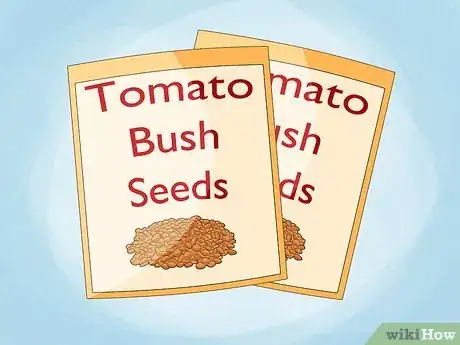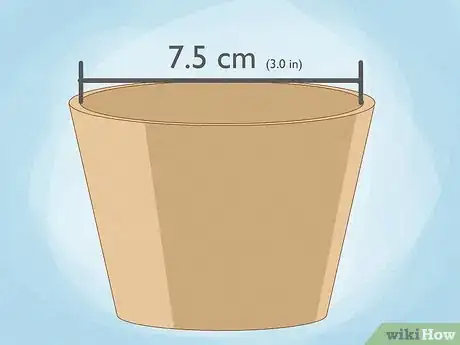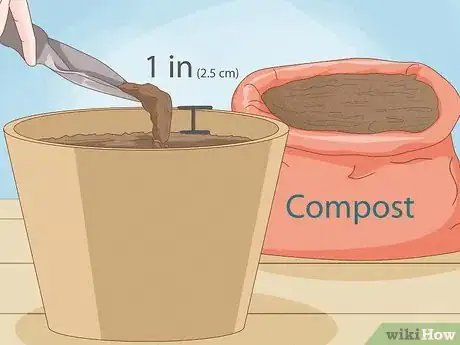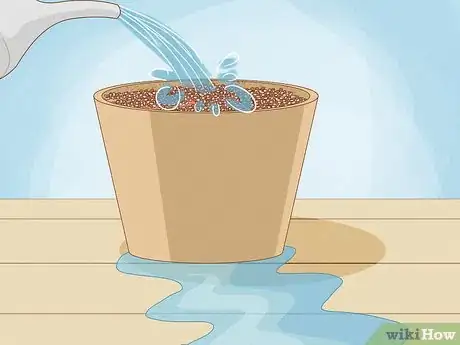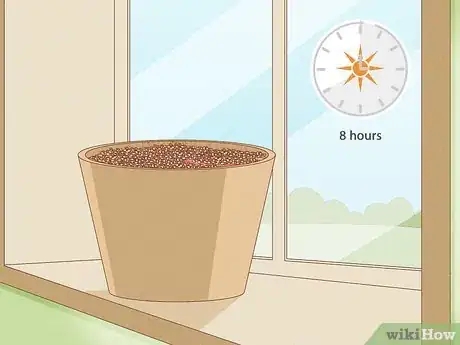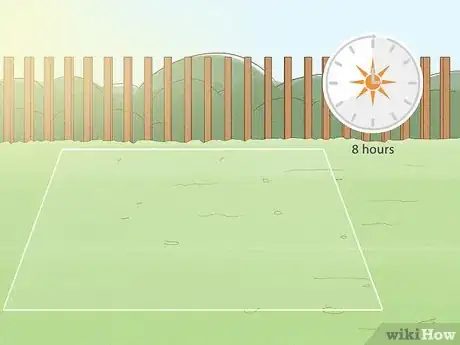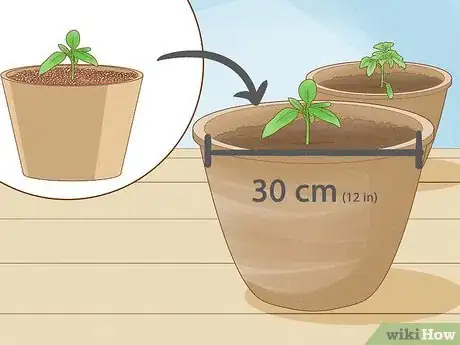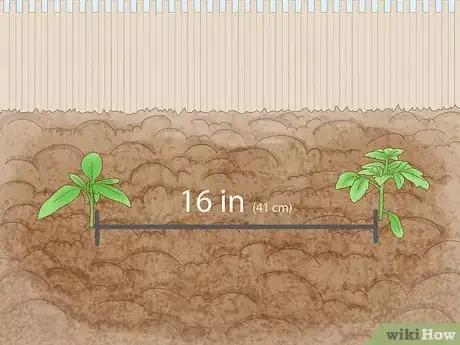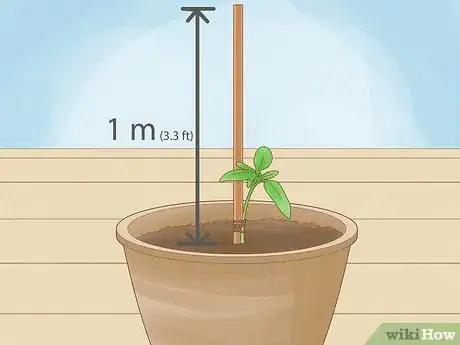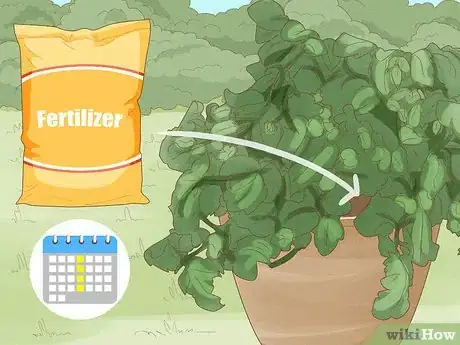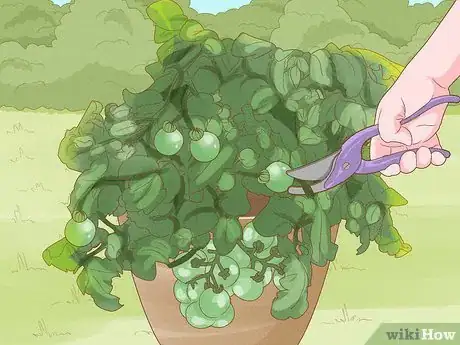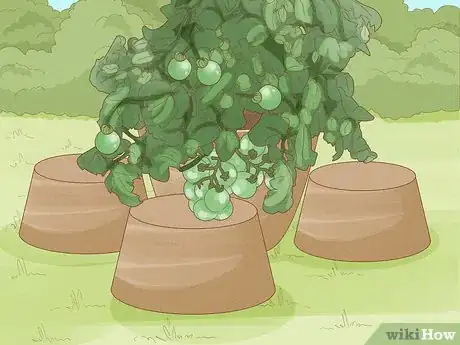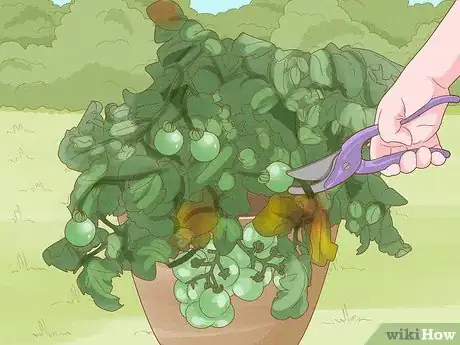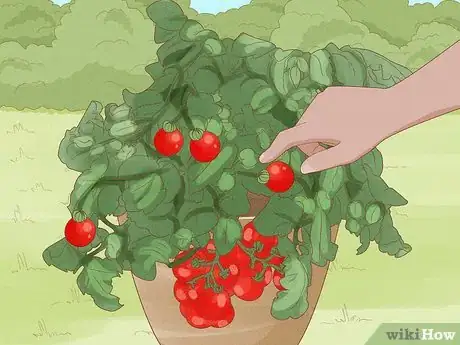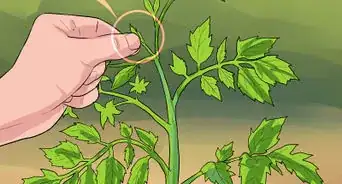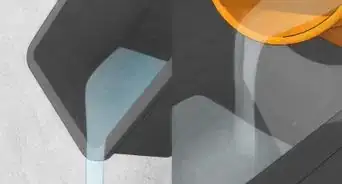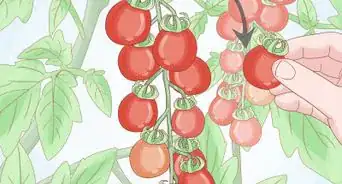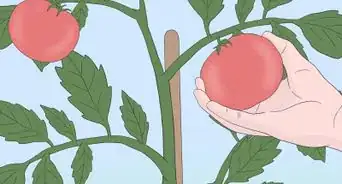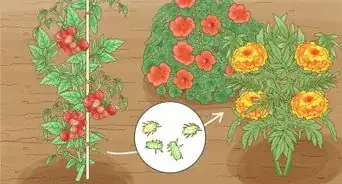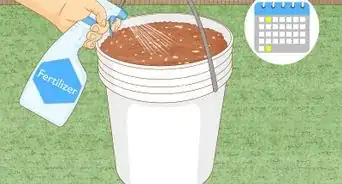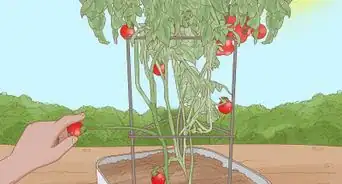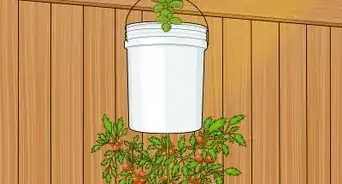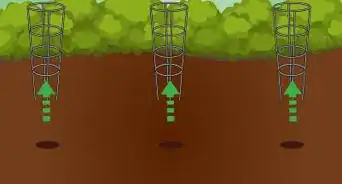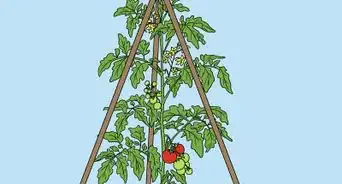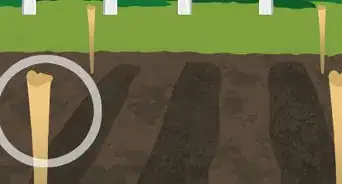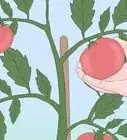This article was co-authored by Monique Capanelli and by wikiHow staff writer, Hannah Madden. Monique Capanelli is a Plant Specialist and the Owner and Designer for Articulture Designs, an innovative design firm and boutique in Austin, Texas. With over 15 years of experience, Monique specializes in interior botanical design, living walls, event decor, and sustainable landscape design. She attended the University of Texas at Austin. Monique is a Certified Permaculture Designer. She provides plant and botanical design experiences, from small gifts to entire transformations, to shoppers as well as commercial clients including Whole Foods Market and The Four Seasons.
There are 9 references cited in this article, which can be found at the bottom of the page.
This article has been viewed 10,091 times.
If you love the taste of a home grown tomato but you aren’t a fan of pruning and taking care of vines, bush tomatoes might be a great choice for you. Bush tomatoes, also called “determinate” tomatoes, grow outward instead of upward, so they don’t require much maintenance at all. After you plant your seeds and nurture the seedlings, you'll be able to start harvesting fresh tomatoes in 50-80 days!
Steps
Planting Seeds
-
1Start your seeds between late January and mid-March. You’ll keep your seeds inside for the first few months, so there’s no chance they’ll get too cold. Grab a packet of seeds from your local nursery to get started.[1]
- Make sure the seeds say “determinate” or “bush” somewhere on the label. That way, you’ll know they aren’t vine tomatoes (or “indeterminate” tomatoes).
-
2Purchase a 7.5 cm (3.0 in) wide pot for every seed. Pick out pots with drainage holes at the bottom so your seeds don’t get too soggy. Make sure every seed has its own pot to give it enough room to grow.[2]
- You can find pots this size at most garden supply stores.
Advertisement -
3Fill each pot with compost. Leave about 1 in (2.5 cm) of room at the top of the pot. Every pot you use will give you one tomato plant, so use as many or as little as you’d like.[3]
- You can make your own compost at home or pick some up at your local nursery.
-
4Press your seed into the compost and cover it with vermiculite. Place 1 seed on top of the compost and lightly press it into the dirt. Add a thin layer of vermiculite, a mineral that will aid nutrients to your compost. Make sure every seed is fully covered before you move on.[4]
- You can find vermiculite at most nurseries.
-
5Water the seeds generously. Give all of your pots a good, long drink of water to set the seeds in the soil. Keep watering until water comes out of the drainage holes in the bottom of the pot.[5]
- Tomatoes need a lot of water, especially when they’re sprouting. Keep the soil evenly moist.
-
6Set your pots on a windowsill with 8 hours of sunlight. If you have a heated propagator, use that instead. Try to keep your seeds around 70 °F (21 °C) for the best growing environment.[6]
- If it’s still super cold where you live, you can cover the pots with plastic wrap to trap heat and condensation.
Transplanting Seedlings
-
1Pick a spot in your yard during late spring that gets 8 hours of light. Even if you grow your tomatoes in pots, you still should choose their location carefully. Your tomatoes will be ready to go outside when the final threat of frost is over. Choose a sunny, unsheltered spot in your yard that gets at least 8 hours of sun per day.[7]
- Bush tomatoes are great for planters and pots since they won’t get very tall.
-
2Transplant your sprouts into 30 cm (12 in) wide pots or containers. Fill your pots with compost and top them with a thin layer of soil. Use a spade to carefully dig your sprouts out of their pots and plant them in the new ones, being sure to cover the roots entirely. Press down lightly on the dirt to make sure the plants are secure.[8]
-
3Plant sprouts 16 in (41 cm) apart if you’re planting them in the ground. If you don’t want to use containers, dig a small hole that’s deep enough for the roots of each sprout. Press your sprouts into the soil, then cover them with a layer of dirt.[12]
- You can also put your tomato sprouts in a raised bed.
-
4Tie each plant loosely to a 1 m (3.3 ft) wooden stake. Plant the wooden stake directly next to each tomato plant. Use twine or string to tie the main stalk of your tomato plant to the stake so it doesn’t fall over.[13]
- You can find bamboo stakes at most nurseries, or you can make your own.
Maintaining and Harvesting
-
1Water the tomatoes every day to keep the soil moist. Tomatoes need a lot of water since they get direct sunlight every day. Make it a habit to water your tomato plants thoroughly at least once a day, and more if it’s really hot out.[14]
- Try to keep the roots moist but not soggy.
- Tomatoes are fairly drought tolerant, so don't overwater them.[15]
-
2Feed the plants tomato fertilizer once tomatoes start growing. Pick up a package of tomato fertilizer and mix in a handful with some plain dirt. Sprinkle the mixture around the base of the tomato plant to add extra nutrients to the soil.[16]
- You can add fertilizer about once a week until the growing season is over.
- Try not to put fertilizer directly on the roots or stalk of your plant. Fertilizer is pretty harsh, and it might chemically burn your plant.
-
3Thin out the foliage if the tomatoes aren't getting sunlight. Bush tomatoes don’t require a ton of pruning since they don’t get super tall. If you notice that any flowers are getting shaded out, use pruners to cut the leaves that are getting too tall.[17]
- Bush plants are known for their easy, low-maintenance pruning schedule. Realistically, if you don’t notice any problems throughout the growing season, you can leave your tomatoes to grow on their own without any maintenance.
-
4Place plant pots underneath heavy branches for support. If your tomatoes look droopy or the fruit is too heavy, set up overturned plant pots for some support. Bush tomatoes tend to grow outward instead of upward, so they might need a little extra help throughout the late growing season.[18]
- You can expect your bush tomatoes to get between 12 and 24 inches (30 and 61 cm) tall.
-
5Pull off any damaged or diseased leaves to keep plants healthy. Your tomatoes will probably be fine on their own, but there is a chance they could get pests or diseases. If you notice any leaves that look dead, crispy, or brown, gently pull them off the plant and throw them in the garbage (not the compost).[19]
- If you notice any insects eating your tomatoes, like aphids, try spraying a mixture of water and 10 drops of peppermint essential oil onto your tomato plants.[20]
-
6Pick the tomatoes when they’re fully ripe. Your tomatoes might take between 50-80 days to ripen depending on the time of year. Try to keep them on the plant as long as you can until they look large and red.[21] When your tomatoes are ready, gently pick them off the plant and bring them inside to enjoy.[22]
- If it starts to get cold out before your tomatoes are fully ripe, pick them while they’re still green and let them ripen inside. They might not taste quite as good as tomatoes ripened on the plant, but they’ll still be great!
- Store fresh tomatoes at room temperature for about 1 week until they go bad.
- Refrigerating tomatoes can help them last longer, but it may give them an unpleasant texture.
How Do You Successfully Grow Tomatoes in Pots?
Expert Q&A
Did you know you can get expert answers for this article?
Unlock expert answers by supporting wikiHow
-
QuestionCan tomatoes be overwatered?
 Monique CapanelliMonique Capanelli is a Plant Specialist and the Owner and Designer for Articulture Designs, an innovative design firm and boutique in Austin, Texas. With over 15 years of experience, Monique specializes in interior botanical design, living walls, event decor, and sustainable landscape design. She attended the University of Texas at Austin. Monique is a Certified Permaculture Designer. She provides plant and botanical design experiences, from small gifts to entire transformations, to shoppers as well as commercial clients including Whole Foods Market and The Four Seasons.
Monique CapanelliMonique Capanelli is a Plant Specialist and the Owner and Designer for Articulture Designs, an innovative design firm and boutique in Austin, Texas. With over 15 years of experience, Monique specializes in interior botanical design, living walls, event decor, and sustainable landscape design. She attended the University of Texas at Austin. Monique is a Certified Permaculture Designer. She provides plant and botanical design experiences, from small gifts to entire transformations, to shoppers as well as commercial clients including Whole Foods Market and The Four Seasons.
Plant Specialist
-
QuestionHow big should a container be for tomatoes?
 Monique CapanelliMonique Capanelli is a Plant Specialist and the Owner and Designer for Articulture Designs, an innovative design firm and boutique in Austin, Texas. With over 15 years of experience, Monique specializes in interior botanical design, living walls, event decor, and sustainable landscape design. She attended the University of Texas at Austin. Monique is a Certified Permaculture Designer. She provides plant and botanical design experiences, from small gifts to entire transformations, to shoppers as well as commercial clients including Whole Foods Market and The Four Seasons.
Monique CapanelliMonique Capanelli is a Plant Specialist and the Owner and Designer for Articulture Designs, an innovative design firm and boutique in Austin, Texas. With over 15 years of experience, Monique specializes in interior botanical design, living walls, event decor, and sustainable landscape design. She attended the University of Texas at Austin. Monique is a Certified Permaculture Designer. She provides plant and botanical design experiences, from small gifts to entire transformations, to shoppers as well as commercial clients including Whole Foods Market and The Four Seasons.
Plant Specialist
-
QuestionHow deep should you plant tomato plants?
 Monique CapanelliMonique Capanelli is a Plant Specialist and the Owner and Designer for Articulture Designs, an innovative design firm and boutique in Austin, Texas. With over 15 years of experience, Monique specializes in interior botanical design, living walls, event decor, and sustainable landscape design. She attended the University of Texas at Austin. Monique is a Certified Permaculture Designer. She provides plant and botanical design experiences, from small gifts to entire transformations, to shoppers as well as commercial clients including Whole Foods Market and The Four Seasons.
Monique CapanelliMonique Capanelli is a Plant Specialist and the Owner and Designer for Articulture Designs, an innovative design firm and boutique in Austin, Texas. With over 15 years of experience, Monique specializes in interior botanical design, living walls, event decor, and sustainable landscape design. She attended the University of Texas at Austin. Monique is a Certified Permaculture Designer. She provides plant and botanical design experiences, from small gifts to entire transformations, to shoppers as well as commercial clients including Whole Foods Market and The Four Seasons.
Plant Specialist Plant them a little deeper in the soil than you think you need to. The stalk needs to start about an inch under the soil—then, pack more soil around the stalk. That's going to allow for sturdier stalk growth. It will also give you better root system, because roots will grow out of the stalk that's under the earth, giving the whole plant more strength.
Plant them a little deeper in the soil than you think you need to. The stalk needs to start about an inch under the soil—then, pack more soil around the stalk. That's going to allow for sturdier stalk growth. It will also give you better root system, because roots will grow out of the stalk that's under the earth, giving the whole plant more strength.
Things You’ll Need
- Tomato seeds
- 7.5 cm (3.0 in) pot
- Compost
- Vermiculite
- 5 cm (2.0 in) pots
- Spade
- Wooden stakes
- Twine
References
- ↑ https://www.gardenersworld.com/how-to/grow-plants/how-to-grow-tomatoes/
- ↑ https://www.gardenersworld.com/how-to/grow-plants/how-to-grow-tomatoes/
- ↑ https://www.rhs.org.uk/advice/profile?pid=315
- ↑ https://www.rhs.org.uk/advice/profile?pid=315
- ↑ https://www.rhs.org.uk/advice/profile?pid=315
- ↑ https://www.rhs.org.uk/advice/profile?pid=315
- ↑ https://anrcatalog.ucanr.edu/pdf/8159.pdf
- ↑ https://www.gardenersworld.com/how-to/grow-plants/how-to-grow-tomatoes/
- ↑ Monique Capanelli. Plant Specialist. Expert Interview. 22 September 2020.
- ↑ Monique Capanelli. Plant Specialist. Expert Interview. 22 September 2020.
- ↑ Monique Capanelli. Plant Specialist. Expert Interview. 22 September 2020.
- ↑ https://www.rhs.org.uk/advice/profile?pid=315
- ↑ https://www.growveg.co.uk/guides/tomato-cages-how-to-make-supports-for-healthier-tomato-plants/
- ↑ https://www.rhs.org.uk/advice/profile?pid=315
- ↑ Monique Capanelli. Plant Specialist. Expert Interview. 22 September 2020.
- ↑ https://www.allotment-garden.org/vegetable/how-to-grow-your-own-tomatoes/growing-tomatoes-outdoors/
- ↑ https://www.growveg.co.uk/guides/tomato-cages-how-to-make-supports-for-healthier-tomato-plants/
- ↑ https://www.gardenersworld.com/how-to/grow-plants/how-to-grow-tomatoes/
- ↑ https://hgic.clemson.edu/factsheet/tomato-diseases-disorders/
- ↑ https://www.slc.gov/sustainability/pesticidefree/alternative-pesticides/
- ↑ https://www.allotment-garden.org/vegetable/how-to-grow-your-own-tomatoes/growing-tomatoes-outdoors/
- ↑ https://extension.unl.edu/statewide/buffalo/Picking%20Ripe%20Tomatoes%2008-30-2014.pdf
